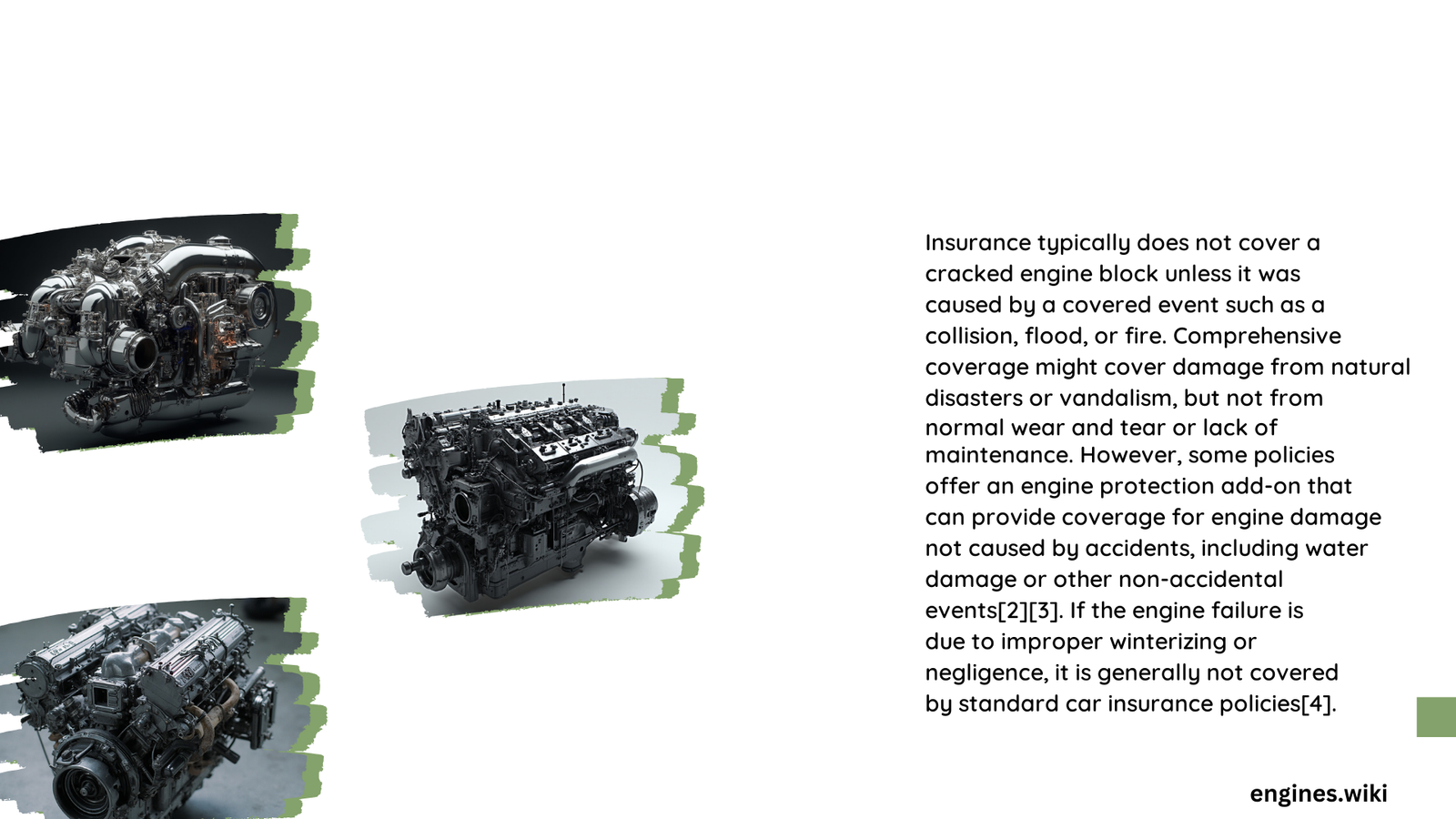A cracked engine block is a severe mechanical issue that can lead to significant repair costs. Many vehicle owners wonder if their insurance policy will cover this type of damage. The coverage for a cracked engine block depends on various factors, including the cause of the damage and the type of insurance policy you have. This comprehensive guide will explore the intricacies of insurance coverage for cracked engine blocks, helping you understand your options and potential financial responsibilities.
What Are the Typical Causes of a Cracked Engine Block?
Before delving into insurance coverage, it’s essential to understand the common causes of a cracked engine block:
- Overheating
- Freezing temperatures
- Manufacturing defects
- Physical impact (e.g., accidents)
- Wear and tear over time
Knowing the cause of the damage is crucial when determining whether your insurance will cover the repairs.
Does Comprehensive Coverage Include Cracked Engine Block Repairs?

Comprehensive coverage is often misunderstood when it comes to engine damage. Here’s what you need to know:
- Covered Events: Comprehensive insurance typically covers damage from events such as:
- Fire
- Theft
- Vandalism
-
Natural disasters (e.g., floods, hurricanes)
-
Mechanical Failures: Generally, comprehensive coverage does not include mechanical failures or wear and tear.
-
Specific Conditions: For a cracked engine block to be covered under comprehensive insurance, it must be a direct result of a covered event.
Example Scenario
If your engine block cracks due to a fire caused by an electrical short circuit, comprehensive coverage would likely apply. However, if the crack is due to normal wear and tear or overheating, it would not be covered.
How Does Collision Coverage Apply to Engine Block Damage?
Collision coverage differs from comprehensive in its application to engine block damage:
-
Accident-Related Damage: If your engine block cracks as a result of a collision, it would typically be covered under collision insurance.
-
Non-Accident Damage: Mechanical failures unrelated to accidents are not covered by collision insurance.
Key Points to Remember
- Collision coverage only applies if the damage is directly caused by an accident.
- Regular maintenance issues or wear and tear are not covered.
What Are the Costs Associated with Engine Block Repair?
Understanding the potential costs can help you appreciate the importance of insurance coverage:
| Repair Type | Estimated Cost Range |
|---|---|
| Minor Crack Repair | $1,500 – $3,000 |
| Major Crack Repair | $3,000 – $5,000 |
| Engine Block Replacement | $5,000 – $10,000+ |
These costs can vary significantly based on:
– Vehicle make and model
– Extent of the damage
– Labor rates in your area
Does Liability Insurance Cover Engine Block Damage?
Many drivers mistakenly believe that liability insurance might cover their own vehicle’s damage. Here’s the reality:
- Purpose of Liability Insurance: It covers damage you cause to other people’s property or injuries to others.
- Your Vehicle: Liability insurance does not cover damage to your own vehicle, including engine block damage.
Important Note
If you only have liability insurance, you will be responsible for all costs associated with repairing or replacing your cracked engine block, regardless of the cause.
What Types of Engine Block Damage Qualify for Insurance Claims?
The type of damage and its cause are crucial in determining insurance coverage:
- Accident-Related Damage
- Covered by: Collision insurance
-
Example: Engine block cracked due to a front-end collision
-
Natural Disaster Damage
- Covered by: Comprehensive insurance
-
Example: Engine block cracked due to flood water
-
Vandalism or Theft
- Covered by: Comprehensive insurance
-
Example: Engine block damaged during an attempted theft
-
Mechanical Failure
- Not typically covered by standard auto insurance
- May be covered by: Mechanical Breakdown Insurance (MBI) or extended warranty
How Are Coverage Limits Determined for Engine Block Damage?
Insurance companies use several factors to determine coverage limits:
- Actual Cash Value (ACV): The current market value of your vehicle
- Policy Limits: The maximum amount your policy will pay out
- Deductible: The amount you’re responsible for before insurance kicks in
Calculation Example
Let’s say your car’s ACV is $15,000, your policy limit is $20,000, and your deductible is $500:
- If the repair cost is $8,000, you would pay $500, and insurance would cover $7,500.
- If the repair cost exceeds the ACV, the insurance company might declare the car a total loss and pay out the ACV minus your deductible.
What Additional Coverage Options Exist for Engine Block Protection?
While standard auto insurance may have limitations, other options can provide more comprehensive protection:
- Mechanical Breakdown Insurance (MBI)
- Covers mechanical failures, including engine block cracks
-
Often available for newer vehicles
-
Extended Warranty
- Can cover engine block repairs after the manufacturer’s warranty expires
-
Terms and coverage vary widely between providers
-
Gap Insurance
- Doesn’t directly cover engine block damage
- Covers the difference between your car’s ACV and what you owe if it’s totaled
How Can You Prevent Engine Block Cracks?
Prevention is often the best strategy:
- Regular maintenance checks
- Proper coolant levels and quality
- Addressing overheating issues promptly
- Protecting your vehicle from extreme temperatures
What Steps Should You Take If You Suspect a Cracked Engine Block?
If you believe your engine block is cracked:
- Stop driving immediately to prevent further damage
- Have your vehicle towed to a reputable mechanic
- Get a detailed diagnosis and repair estimate
- Contact your insurance provider to discuss coverage options
- Consider all repair and replacement options before making a decision
Understanding your insurance coverage and the factors that influence it is crucial when dealing with a cracked engine block. While standard auto insurance policies may have limitations, exploring additional coverage options can provide peace of mind and financial protection against this potentially costly repair.
